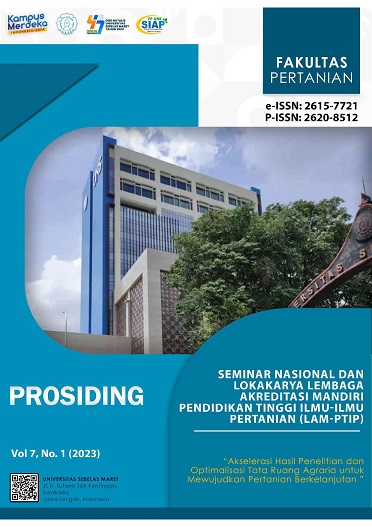Pengaruh Herbisida Majemuk 2,4-D Natrium + Etil klorimuron 4% sebagai Pengendali Gulma Berdaun Lebar dan Teki pada Budidaya Padi Sawah (Oryza sativa L.)
Keywords:
Herbicide, 2,4-D Sodium 76% Ethyl chlorimuron 4%, Weeds, Lowland RiceAbstract
Weeds are one of the plant-distrurbing organism that can reduce the productivity of
rice plants due to competition in term of absorption of nutrients, water, sunlight, and space to
grow. Weed control using systemic and selective herbicides is considered to be more effective
in controlling weeds in lowland rice cultivation compared to other controls. This study aims to
determine the effect of various doses of mixed herbicides 2,4-D Sodium 76% + Ethyl
chlorimuron 4% on weed growth and productivity of lowland rice varieties Ciherang. This
experiment was carried out from June to September 2022 at the SPLPP (Sanggar Penelitian
Latihan dan Pengembangan Pertanian), Faculty of Agriculture, Padjadjaran University. The
experimental design used was a randomized block design (RBD) with six treatments and four
replications, namely A = 2,4-D 76% sodium + 4% ethyl chlorimuron (240 g/ha), B = 2,4-D
sodium 76% + Ethyl chlorimuron 4% (320 g/ha), C = 2,4-D Sodium 76% + Ethyl chlorimuron
4% (400 g/ha), D = 2,4-D Sodium 76% + Ethyl chlorimuron 4 % (480 g/ha), E = Manual
weeding, F = No treatment (Control). The experimental results showed that the herbicide
treatment with a mixture of 2,4-D Sodium 76% + Ethyl chlorimuron 4% 240 – 480 g/ha was
effective for controlling broadleaf weeds and sedges, namely Specochlea zeylanica, Ludwigia
octovalvis, Cyperus difformis, Echinochloa cruss galli, and Monochoria vaginalis and gave
the highest yield of Ciherang variety, namely 6.18 tons/hectare.



